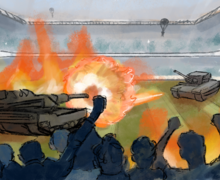Saffren: ‘Saturday Night Live’ will overcome transition period in upcoming season after losing core cast members
“Saturday Night Live” is dead – just like it was in 1980, 1986, 1995 and 2005.
The 39th season premiere of “SNL” will premiere Sept. 28. The show has lost seven core cast members in three years and is on the verge of yet another transition season – when every sketch is a desolate wasteland of crickets and confusion.
With every past transition season, pundits and fanatics have questioned whether the show can bounce back. But each time, “SNL” survives because it is a monopoly in live sketch comedy. With no competitors, the show always reloads with the best amateur comedians from around the country.
“SNL” has a recurring history during which core cast members make the show great for five-, six- or seven-year periods and then leave together, leading to a transition season about once a decade.
Will Forte started the latest mass exodus in 2010. Andy Samberg and Kristen Wiig, the stars most responsible for rescuing “SNL” from its mid-2000s doldrums, followed him out after the 2012-13 season. Jason Sudeikis, Bill Hader and Fred Armisen, the other members of the new millennium core, are not returning this season. Head writer and “Weekend Update” anchor Seth Meyers will depart in December to replace Jimmy Fallon on NBC’s “Late Night.”
Unless Bobby Moynihan and Keenan Thompson become funny, or the five new cast members are the most groomed rookie class in history, 2013-14 will join a futile collection of seasons that includes 1980-81, 1985-86, 1994-95 and 2004-05.
Despite the overhaul, there is still enthusiasm for the future of the late-night series. It has always recovered from this transitional situation in the past by transforming its cast.
Before 1980-81, “SNL” lost the “Not Ready for Primetime Players” cast that made it a hit during its first five seasons. Then Eddie Murphy made the show raw and diverse.
After 1985-86, NBC briefly considered cancelling “SNL” due to poor ratings. Then Dana Carvey and Mike Myers made it chaotically goofy.
After 1994-95, nine cast members were fired. Then Will Ferrell started getting naked and making castmates break into laughter mid-performance.
In 2004-05, the show had no stars. Then Samberg made it digital and Wiig made it perversely awkward.
Ostensibly, the show’s monopoly is one of the great curiosities of modern television. How, in an era in which every show format has been replicated like nucleotides on a DNA strand, has no other network capitalized on live sketch comedy?
The answer is simple. Thanks to early success, “SNL” is synonymous with live sketch comedy, which is why it has outlasted all of its competitors, like ABC’s “Fridays” and Fox’s “MadTV.”
If “SNL” had a worthy rival, sketch comedy would become trite and commonplace. No one would care who is hosting or performing every week because there would be a bunch of hosts and performers on different shows.
As long as there is an audience for sketch comedy, “SNL” will always re-emerge from its periodic doldrums.
We love watching comedians tear apart the modern zeitgeist with wit and tomfoolery. We love watching them mock our political demagogues. We really love watching non-comedians, the host and musical guest attempt to be funny by mocking themselves.
Because of this, the audience and amateur talent pool for “SNL” will continue to burgeon. So suffer through this transitional wasteland, “SNL” fanatics. Demise will be greatly exaggerated.
Jarrad Saffren is a senior political science major. He can be reached at jdsaffre@syr.edu and followed on Twitter @JarradSaff.
Published on September 18, 2013 at 2:04 am





